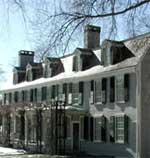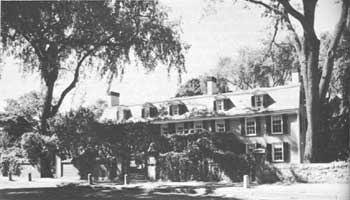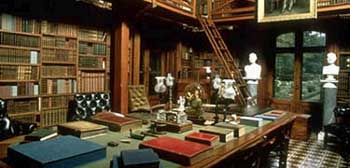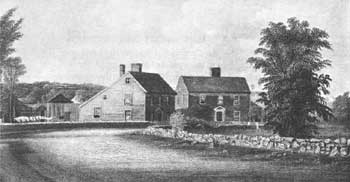





Survey of Historic Sites and Buildings
  |
ADAMS NATIONAL HISTORICAL PARK Massachusetts |
 Adams National Historical Park |
| ||
This site, which features the Adams Mansion, is a memorial to four generations of the Adams family, distinguished in American politics and intellectual life. In the mansion resided Presidents John Adams and John Quincy Adams; Charles Francis Adams, U.S. Minister to Great Britain during the Civil War; and the celebrated writers and historians Henry and Brooks Adams.
John Adams (1735-1826) was the first Vice President and second President of the United States. He was graduated from Harvard College in 1755, a decade or so later actively opposed the Stamp Act, and in 1774 represented the colony of Massachusetts as a delegate to the First Continental Congress. After fighting began at Lexington, he took a leading part in the Second Continental Congress, was one of those involved in the movement for independence, and helped choose Washington as commander in chief of the Army. Adams was also one of the Committee of Five, which drafted the Declaration of Independence.
After Burgoyne's surrender at Saratoga, in 1777, Adams was appointed commissioner to France and with his 10-year-old son, John Quincy, sailed for Europe in 1778. Later he served as Minister Plenipotentiary to Holland, from which country he obtained loans. Together with Benjamin Franklin and John Jay, on September 3, 1783, he signed the peace treaty with Great Britain that recognized the independence of the United States. In 1785 he served as Envoy to Britain, where he remained until 1788. Few contributed more to independence and foreign recognition.
 |
| "Peacefield," or the "Old House," in Quincy, Massachusetts, was the home of four generations of the Adams family, including Presidents John and John Quincy Adams. The Adams Mansion is now a part of Adams National Historical Park. |
Together with Franklin and Jefferson he selected the motto E Pluribus Unum (One Out of Many) for use on the Great Seal of the United States. In the Government under the Constitution, he held the office of Vice President. Elected to the Presidency in 1796, he served ably and prevented a war with France. In 1801 he retired to his home in Quincy, but never lost his avid interest in public questions. He lived to see his son elected to the Presidency, and died on July 4, 1826, the same day as Thomas Jefferson. John's wife, Abigail, a remarkable woman in her own right and first mistress of the White House, was the only woman in our history to have been the wife of one President and the mother of another.
John Quincy Adams (1767-1848) as a boy accompanied his father to Europe, in 1778. During his father's ministry to Great Britain, he returned to America and in 1787 was graduated from Harvard College. Seven years later Washington commissioned him Minister to the Netherlands, and during his father's Presidency he was Minister to Prussia. In 1803 he won election to the U.S. Senate, where he demonstrated independence of mind by supporting Jefferson's embargo as am alternative to war. In 1809 President Madison appointed him Minister to Russia, where he witnessed many stirring events in the reign of Tsar Alexander I. Refusing a nomination to the Supreme Court of the United States, he remained in Europe as one of the U.S. peace commissioners for the War of 1812. On December 24, 1814, he signed the Treaty of Ghent, which ended the war. In Paris he witnessed Napoleon's triumphal return from Elba, the prelude to Waterloo.
Adams next went to England as Minister to the Court of St. James. In 1817 he became President Monroe's Secretary of State and negotiated with Spain for the cession of the Floridas, which culminated in the Adams-Onis Treaty of 1819. He took a prominent part in the recognition of the Latin American Republics and was jointly responsible with the President for the promulgation of the Monroe Doctrine. In 1825 he became the sixth President of the United States. Four years later he retired to Quincy, hopefully to write history. But within 2 years he was elected to Congress, where he served continuously for 17 years—the only ex-President to become a Member of the House of Representatives. At the age of 81, stricken on the floor of the House, he literally died at his post.
 |
| Adams National Historical Park. |
Charles Francis Adams (1807-86), son of John Quincy, followed his father and grandfather in public life and fathered four distinguished sons. His father took him at the age of 2 to St. Petersburg and later to Paris. In 1825 he was graduated from Harvard University, and 4 years later was admitted to the bar. After serving in the Massachusetts Legislature, in 1848 he was nominated for Vice President on the Free Soil ticket with Van Buren. He was elected to Congress in 1858 and 1860. The following year President Lincoln chose him as Minister to the Court of St. James, a post held by his father and grandfather, in which he served with distinction throughout the Civil War. Resigning in 1868, he declined the presidency of Harvard University and retired to Quincy. He returned to Europe as one of the arbitrators who passed upon the Alabama claims at Geneva. An accomplished historian, author, and biographer of his grandfather, he also published the letters and diaries of various members of the family.
The four sons of Charles Francis Adams—John Quincy II (1833-94), Charles Francis, Jr. (1835-1915), Henry (1838-1918), and Brooks (1848-1927)—all had highly successful careers. All of them, like their father, grandfather, and great grandfather before them, graduated from Harvard. And they distinguished themselves in politics, literature, historiography, and public service.
The Adams Mansion, named "Peacefield" by John Adams, but known later to the family as the "Old House," was dear and close to all of them. In 1731 Maj. Leonard Vassall, a wealthy West Indian sugar planter who had come to Massachusetts some 8 years before, built the oldest part of the house. It consisted of only three rooms on the ground floor, two bed rooms on the second floor, and three smaller rooms in the attic. The kitchen and servants' quarters were not attached to the house.
John Adams, while still Minister to Great Britain, bought the house in September 1787 from the major's grandson, Leonard Vassall Borland, and on his return in 1788 took possession of the property. During his Presidency he built the large gabled ell containing the long room, east entry, and upstairs study. In 1836 John Quincy Adams added the passage along the north side of the house connecting the two ells. In 1869 Charles Francis added 30 feet to the kitchen ell for servants' quarters, and the following year built the stone library overlooking his grandmother's gar den, and, in 1873, the stone stable. In 1906 Brooks added the present entrance gates.
After his retirement from the Presidency, in 1801, John Adams lived in the house the year round until his death, in 1826. John Quincy Adams and Charles Francis Adams made it their summer home, and both Henry and Brooks spent many summers there. Much of the furniture within the house reflects the diplomatic background of John, John Quincy, and Charles Francis Adams, for they all returned with prized possessions from their European missions.
The continuity of life in the house is best shown by the furnishings, for the various objects are of successive periods—each generation contributing something. The house is not a "period piece" but one that clearly shows the ever-changing style and taste of its occupants, from 1788 to 1927.
In 1946 the Adams Memorial Society donated the property to the Federal Government. Consisting of almost 5 acres, it includes the house, library, garden, and stables. It is open to the public from April 19 through November 10.
 |
| Adams National Historical Park. |
John Adams Birthplace
Location. Norfolk County, 133 Franklin Street, Quincy.
Significance. This house was the original homestead of the Adams family and the birthplace of John Adams—lawyer, statesman, diplomat, and second President of the United States. Although not architecturally significant, it is historically notable as the birthplace of John Adams and the house in which he grew to manhood before embarking upon his public career. It is next door to the John Quincy Adams Birthplace. In 1720 John Adams' father, "Deacon" John Adams, bought it. Growing to manhood in the house, young John lived there until or shortly before his marriage, in 1764, when he and his bride moved into a neighboring house that in 1761 he had inherited from his father and where in 1767 his son John Quincy was born. In 1774 John purchased his birthplace home from his brother. His public duties kept him away most of the time. By 1783, when he and his family were in Europe, tenants had occupied both the John Adams Birthplace and the neighboring house, the John Quincy Adams Birthplace. In 1788, when John Adams returned from Europe, he settled in a third house, the "Old House," now Adams National Historical Park, in another part of Quincy, and in 1803 sold his birthplace to his son John Quincy. The John Adams Birthplace remained in possession of the Adams heirs until 1940, when they deeded it to the city of Quincy.
Present Appearance. The John Adams Birthplace is of typical New England saltbox design and has been considerably altered over the years. Probably built about 1681, it originally consisted of two lower rooms and two upper chambers and had a massive central chimney. The later lean-to, built early but at an unknown date, added two lower rooms and two small upper chambers having a large attic space between. The house is open to the public.
NHL Designation: 12/19/60
 |
| The birthplace homes of John and John Quincy Adams, Quincy, Massachusetts. From an engraving, probably by Stephen A. Schouff. Courtesy, Library of Congress. |
John Quincy Adams Birthplace
Location. Norfolk County, 141 Franklin Street, Quincy.
Significance. This house, directly adjacent to the John Adams Birthplace, was John Adams' law office and the birthplace of his son John Quincy Adams, sixth President of the United States. In 1761 John inherited the house, the oldest part of which may date from 1663, from his father. At the time of his marriage, in 1764, he moved from the neighboring house, his birthplace, to this one, in which he could house his growing library and set up a law office. For several years he used the kitchen as a law office. In the house, on July 11, 1767, John Quincy Adams was born. After 1772 John's growing law practice made it convenient for him to live in Boston most of the time, but his wife and son remained in the house until after the War for Independence. By 1783, when the family was in Europe, tenants were occupying it. After returning to the United States in 1788, John Adams moved into the "Old House," now Adams National Historical Park, in another part of Quincy. In 1803 John Quincy purchased both birthplaces from his father, and from 1805 to 1807 occupied his birthplace house. In 1940 the Adams heirs deeded the house, along with the John Adams Birthplace, to the city of Quincy.
Present Appearance. The John Quincy Adams Birthplace is in excellent condition, though it is not architecturally significant. Like the John Adams Birthplace, it is of typical New England saltbox design, originally consisted of two upper and two lower rooms, and has been extensively altered over the years. John Adams added a lean-to at the rear of the house for a new kitchen during the time he occupied the original kitchen as a law office. The house is open to the public.
NHL Designation: 12/19/60
 |
 |
http://www.cr.nps.gov/history/online_books/founders-frontiersmen/sitea14.htm
Last Updated: 29-Aug-2005